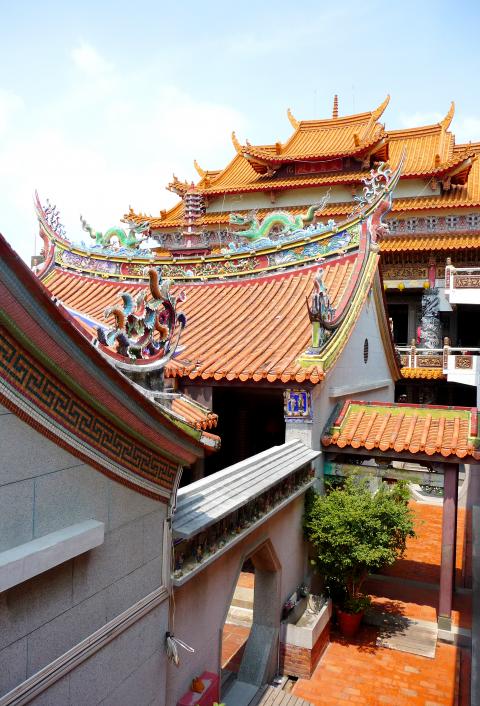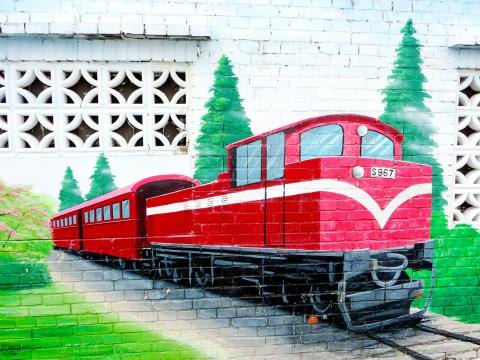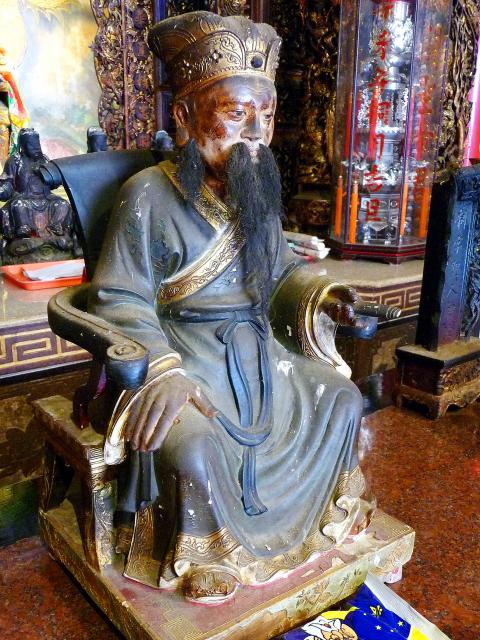Like many places in Taiwan, Shanhua (善化) has had more than one name in its history. The first recorded was Bakaloan, a toponym used by the local Siraya indigenous people, and written 目加溜灣 by Holo-speaking Han settlers.
The Dutch East India Company in 1635 seized this corner of what’s now Tainan and endeavored to Christianize the inhabitants. After the Dutch were thrown out, the Kingdom of Dongning — the statelet established by Zheng Chenggong (鄭成功, also known as Koxinga ) and his band of Ming-dynasty loyalists — decreed that the settlement would be known as Shanhua. However, when Taiwan became part of the Qing Empire, the place name was changed to Wanlishe (灣裡社).
PROMOTING LITERACY

photo by Steven Crook
One man who lived here for a major part of the Dongning era is now revered as a pioneer of classical Chinese education in Taiwan. Shen Kuang-wen (沈光文) was born in China’s Zhejiang Province in 1612, but after the collapse of the Ming dynasty in 1644 he was forced to flee southward. After living for a while in poverty, he sailed to Taiwan a few months after Zheng Chenggong’s death. Hagiographies that have him arriving in Taiwan as early as 1649 have been shown to be wrong.
Shen’s efforts to promote literacy and Han civilization have earned him a place on the altar inside Shanhua’s most historic place of worship, Qingan Temple (慶安宮). The temple stands on the town’s busiest thoroughfare, right where — so it’s said — a Protestant church existed during the Dutch period. This site hosted a Confucius Temple at the beginning of the 18th century, then a shrine dedicated to Wenchang Dijun (文昌帝君), a god of culture and literature and the patron deity of those about to sit academic examinations.
That structure was wrecked in an earthquake in 1861, and the name Qingan Temple first appeared four years later when its replacement was completed. The principal deity nowadays is Mazu (媽祖). In the hall behind her, Guan Yu (關羽) occupies the central position.

photo by Steven Crook
In front of Guan Yu, there are five soot-covered non-identical effigies of Wenchang Dijun. On the left, and slightly closer to those offering incense, another and somewhat less begrimed statuette represents Shen.
There are a couple of other reminders of the scholar elsewhere in the town. Shanhua Junior High School has a Kuang-wen Building (光文樓). Just north of Shanhua Taiwan Railway Administration Station, and clearly visible from trains, the Shen Kuang-wen Memorial (沈光文紀念碑) was dedicated in 1978. It’s believed Shen, who died in 1688, was buried hereabouts.
SUGAR INDUSTRY

photo by Steven Crook
Even before Shen’s arrival in Shanhua, sugar had emerged as an important part of the local economy. The Dutch incentivized farmers to grow sugarcane because the commodity fetched a good price in Japan.
Sugar remained a key cash crop after the Europeans left, but physical remnants of the industry that existed before the Japanese colonial period are few and far between. Earlier this year, however, Tainan City Government’s Cultural Affairs Bureau announced an important discovery in Shanhua. During excavations ahead of a house construction, a set of six “stoves” used to produce sugar more than 150 years ago was found. Whether they will be preserved in situ or moved elsewhere has yet to be decided.
In 1946, when the incoming Chinese Nationalist Party (KMT) government created Taiwan Sugar Corp (TSC) to take control of the island’s sugar industry, Taiwan had 42 sugar factories and refineries. Several of them had sustained damage during World War II; the US Air Force targeted sugar-industry sites because they supplied ethanol to the Japanese military. Before the war, Taiwan was the world’s no. 4 source of sugar, and cane plantations covered a fifth of the island’s farmland. In the early 1950s, sugar exports accounted for 73.6 percent of the country’s foreign-currency earnings.

photo by Steven Crook
TSC even had its own railway network. A few remnants of the narrow-gauge branch lines that use to criss-cross the industry’s heartlands can be found beside the roads that approach Shanhua Sugar Factory (善化糖廠), one of the last two sugar factories still operating in Taiwan. (The other is in Huwei (虎尾) in Yunlin County; TSC’s sugar refinery in Siaogang (小港), not far from Kaohsiung International Airport, also continues to function.)
If you arrive on one of the approximately 110 days per year that the sweet stuff is being produced, you’ll notice a pleasant odor as soon as you enter that part of the complex that’s open to the public. The unmarried-employees quarters look a little tatty, but the redbrick former dormitory next door is pristine and appealing. A renovation/repurposing project to convert it into a restaurant with indoor and outdoor-seating is almost complete. A steam locomotive imported from Belgium in 1948 is preserved here.
Another small building houses Shanhua Sugar Museum (善糖文物館, open 9:30 am to 4pm daily; free admission). There’s very little English inside, yet fans of industrial heritage are sure to enjoy the mechanical calculators, the early 1970s Chinese-script typewriter and the soil-analysis equipment.
Several black-and-white photos deserve careful examination. One shows a TSC train on a stretch of track with three rails, the outer two being 1,067mm apart for the use of Taiwan Railways Administration rolling stock, the inner rail marking the 762mm gauge that was TSC standard.
About 2.5km from the sugar factory, and a few hundred meters west of the high-speed railway, Hucuoliao Painted Village (胡厝寮彩繪村) attracts a trickle of photographers.
Unlike Taichung’s famous Rainbow Village (彩虹眷村), Hucuoliao isn’t a former military dependents’ village, but rather an ordinary rural community. Many of the paintings depict cartoon characters or fairy tales like Little Red Riding Hood, but there are also some well-executed emblems of Taiwan. Thanks to the black-faced spoonbills and the Alishan logging train, even the most humorless patriot will find a satisfactory backdrop for selfies.
Steven Crook has been writing about travel, culture, and business in Taiwan since 1996. Having recently co-authored A Culinary History of Taipei: Beyond Pork and Ponlai, he is now updating Taiwan: The Bradt Travel Guide.

Many people noticed the flood of pro-China propaganda across a number of venues in recent weeks that looks like a coordinated assault on US Taiwan policy. It does look like an effort intended to influence the US before the meeting between US President Donald Trump and Chinese dictator Xi Jinping (習近平) over the weekend. Jennifer Kavanagh’s piece in the New York Times in September appears to be the opening strike of the current campaign. She followed up last week in the Lowy Interpreter, blaming the US for causing the PRC to escalate in the Philippines and Taiwan, saying that as

US President Donald Trump may have hoped for an impromptu talk with his old friend Kim Jong-un during a recent trip to Asia, but analysts say the increasingly emboldened North Korean despot had few good reasons to join the photo-op. Trump sent repeated overtures to Kim during his barnstorming tour of Asia, saying he was “100 percent” open to a meeting and even bucking decades of US policy by conceding that North Korea was “sort of a nuclear power.” But Pyongyang kept mum on the invitation, instead firing off missiles and sending its foreign minister to Russia and Belarus, with whom it

The Chinese Communist Party (CCP) has a dystopian, radical and dangerous conception of itself. Few are aware of this very fundamental difference between how they view power and how the rest of the world does. Even those of us who have lived in China sometimes fall back into the trap of viewing it through the lens of the power relationships common throughout the rest of the world, instead of understanding the CCP as it conceives of itself. Broadly speaking, the concepts of the people, race, culture, civilization, nation, government and religion are separate, though often overlapping and intertwined. A government

Nov. 3 to Nov. 9 In 1925, 18-year-old Huang Chin-chuan (黃金川) penned the following words: “When will the day of women’s equal rights arrive, so that my talents won’t drift away in the eastern stream?” These were the closing lines to her poem “Female Student” (女學生), which expressed her unwillingness to be confined to traditional female roles and her desire to study and explore the world. Born to a wealthy family on Nov. 5, 1907, Huang was able to study in Japan — a rare privilege for women in her time — and even made a name for herself in the